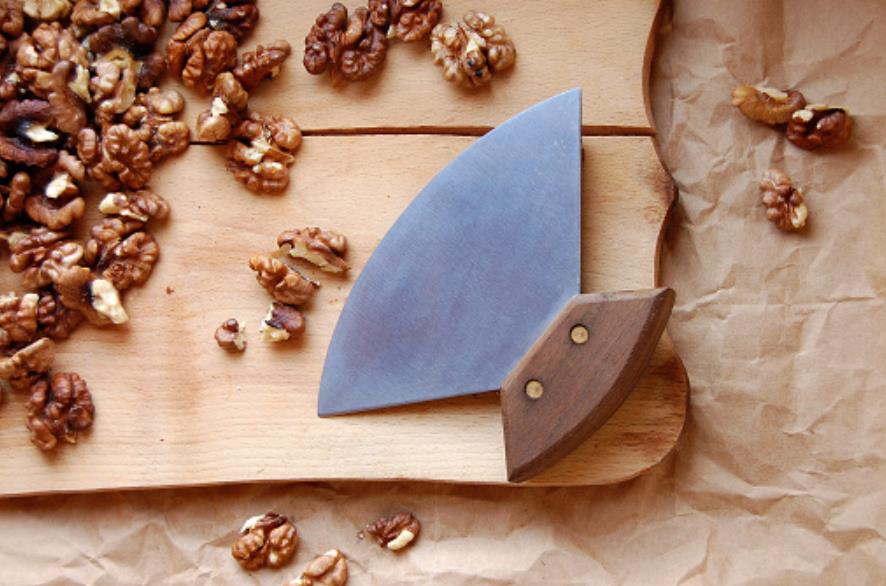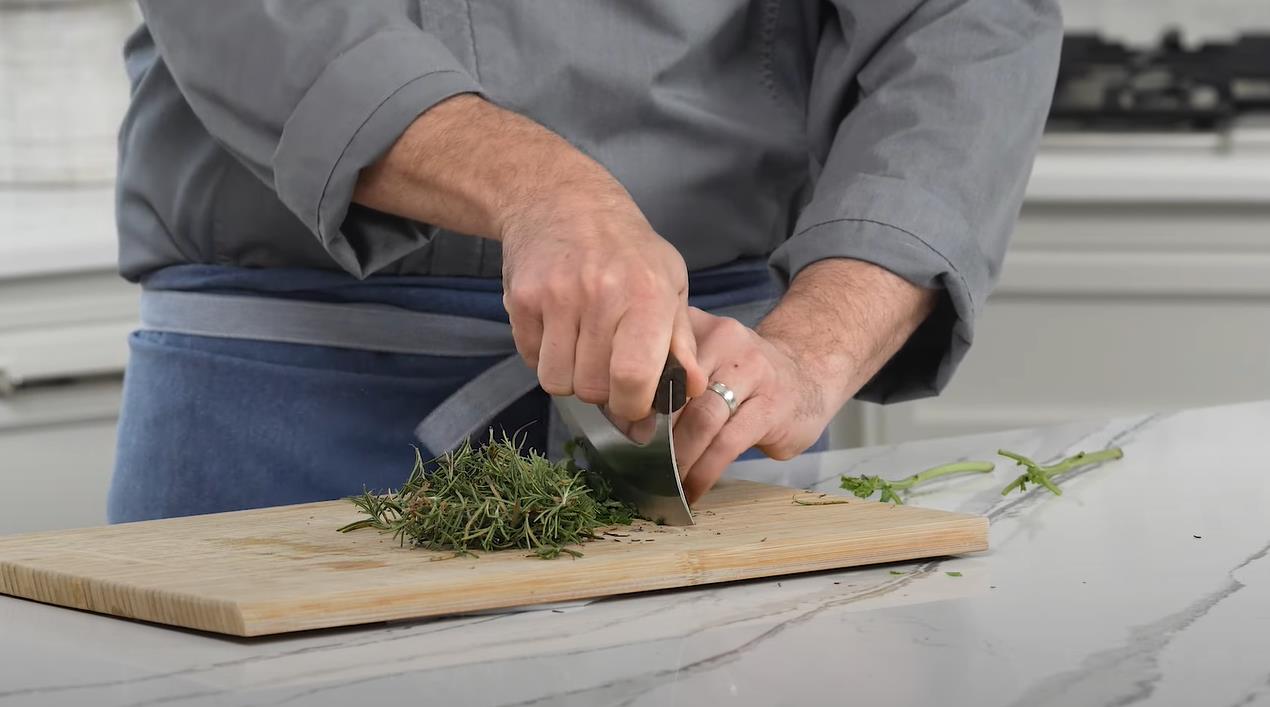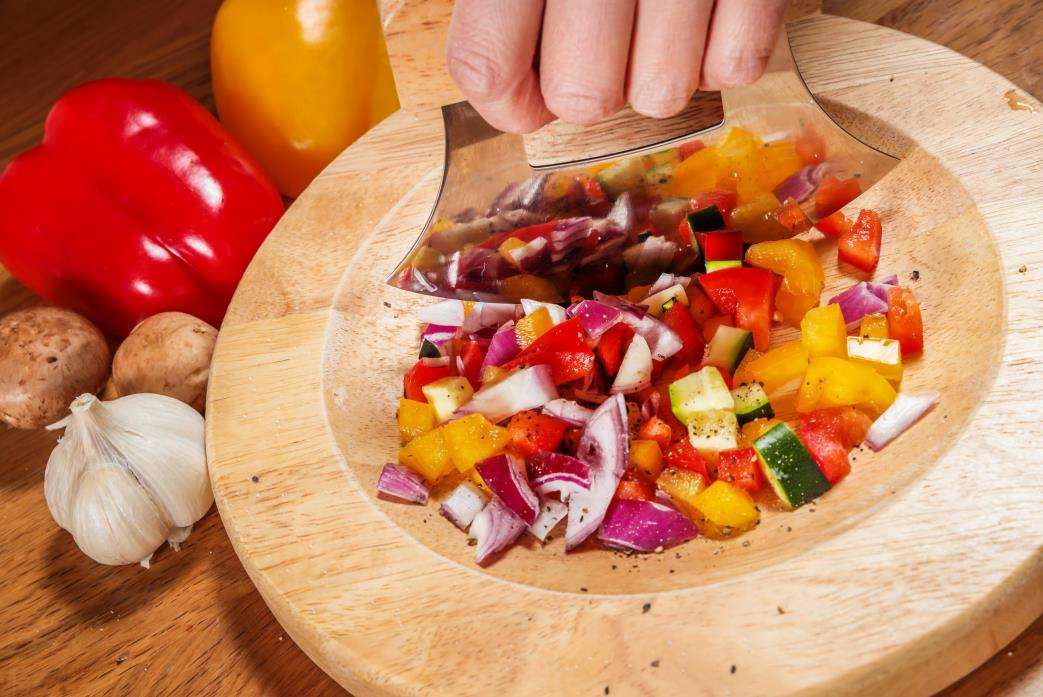The Ulu knife, a traditional Inuit cutting tool, has not only been a part of Inuit culture for generations but has also found its way into the modern kitchen. With its curved blade and handle, this unique and versatile kitchen knife offers a range of benefits that make it a valuable tool for anyone who enjoys cooking and wants to explore different culinary traditions.
An Ulu knife has so many uses. Initially, the Inuit people used the knife to skin and fillet fish, cut meat, and prepare animal hide for clothing. In addition to the traditional uses, modern chefs use Ulu knives to cut cheese, slice pizza, mince onions, spread butter, cut vegetables, and slice fruits.
In this article, we will describe what an ulu knife is, its design variations, its explore its uses further. We’ll also advise whether you should consider adding one to your kitchen knife collection.
Table of contents
What is an Ulu knife?
An Ulu knife is a traditional knife used by the Inuit, Yupik, and Aleut tribes, indigenous to the Arctic regions of Alaska, Canada, and Greenland. These communities have been using the Ulu knife for centuries, with the earliest known Ulu knife dating back to around 2500 BCE.
It’s a unique knife with a semi-circular blade sharpened on one edge (sometimes both) and often has a wooden, bone, or synthetic handle. Traditionally, blacksmiths used materials such as caribou antlers or walrus ivory to make Ulu knife handles. Modern-day manufacturers typically use steel or other metals, but historically the knife featured materials like copper, slate, or obsidian.
The word “Ulu” comes from the Inuktitut language, spoken by the Inuit people of Canada and parts of Greenland. In Inuktitut, the word “Ulu” means “woman’s knife” or “women’s knife.” The name “Ulu” refers to the fact that historically, the Ulu knife was primarily used by Inuit women for cutting and preparing food, such as fish and game, and other domestic purposes.
Ulu knife design and variations

The design of the Ulu knife features a curved blade attached to a handle at a right angle. Typically, blacksmiths use a single piece of metal, such as steel, to make the blade, which they later sharpen along the curved edge. The handle can be made from various materials, such as wood, bone, antler, or ivory.
The basic design of the Ulu knife has remained relatively consistent over time. Still, you can find variations in the blade and handle from different regions.
Here are some of the common variations.
- Blade shape: The blade of the ulu knife is typically crescent-shaped, but the degree of curvature can vary. Some knives have a more pronounced curve, while others, like East Greenwood ones, have a shallower curve. The blade may also be broader or narrower depending on the intended use.
- Handle material: The handle of the ulu knife may be made from various materials, including wood, bone, antler, or plastic. The type of handle material used will affect the knife’s weight, balance, and grip.
- Blade thickness: The thickness of the blade can also vary depending on the maker and the knife’s intended use. Thicker blades are more durable and better suited for heavier tasks like chopping, while thinner blades are better suited for slicing and precision work.
- Handle shape: Some handles are more ergonomic, with a shape designed to fit comfortably in the hand. Others may be more ornate, with decorative carvings or inlays.
- Blade size: Ulus come in a range of sizes, from small knives that are only a few inches long to larger knives that are several inches long. The size of the blade will affect its weight and balance, as well as the tasks for which it is best suited. Ulu knife blades from Barrow, Alaska, are considerably larger than those from Nome, Alaska.
- Blade edge: Some ulu knives have a single beveled edge, while others have a double-beveled edge. The double-beveled edge is more common in modern ulu knives, as it is easier to sharpen and provides better control when slicing.
While most Ulu blades are symmetrical, we also have unsymmetrical or asymmetrical Ulu knives. Asymmetrical Ulu knives feature blades that offset to one side of the handle. This design choice can have a few different implications for how chefs use the knife and how it feels.
Handpicked for you
True cutting power in the palm of your hand
Here are several benefits and drawbacks:
- Ergonomics: The offset blade design allows for a more natural hand position when using the knife, allowing a chef’s wrist to settle neutrally on the handle. As such, it can reduce strain and fatigue during extended use.
- Cutting efficiency: The offset blade design can also provide greater cutting efficiency, as the blade can be angled more directly towards the cutting surface. It can result in cleaner cuts and less effort to complete a cut.
- Aesthetic appeal: Some knife makers may create an unsymmetrical design simply for its unique or eye-catching appearance. The asymmetry can create an interesting visual contrast between the blade and the handle, which can be visually appealing to some users.
- Balance: One potential drawback of an unsymmetrical ulu knife is that it may feel unbalanced or awkward to some users. The weight of the blade may shift to one side, which can affect the overall balance of the knife.
- Different learning curve: Another drawback is that the offset blade design may require some adjustment for users accustomed to using symmetrical ulu knives, as the rocking motion will be slightly different.
Ulu knife uses/How to use an Ulu knife

The Ulu knife is a versatile, multipurpose knife. Here are some traditional and modern uses of the Ulu knife in the kitchen:
- Slicing meat: The ulu knife’s sharp edge can easily slice through meat, including tougher cuts like steak and roast. You can also use the knife to slice cured meats like ham and prosciutto thinly.
- Chopping vegetables: The curved blade makes it ideal for chopping vegetables and herbs. The blade’s rocking motion allows for a smooth and efficient chopping process.
- Crushing garlic: You can use the Ulu knife to crush the garlic. Simply place the garlic on a cutting board and roll the Ulu knife over it.
- Cracking open shellfish: The Ulu knife’s curved blade can easily crack open crab or lobster shells. Hold the shellfish in one hand and use the Ulu knife to apply pressure to crack open the shell.
- Sectioning fruits: The Ulu knife’s curved blade can easily slice through fruits, such as watermelon or pineapple. Hold the handle and cut through the fruit with a sawing motion, then use the curved blade to remove the sections.
- Shredding cheese: The Ulu knife can quickly shred cheese into small pieces. Hold the cheese with one hand and use the Ulu knife to make thin, uniform cuts.
- Trimming fat: The sharp Ulu knife can easily remove excess fat from meat, such as beef or pork. Hold the handle and use a slicing motion to trim away the fat.
- Cutting pizza: The Ulu knife’s rounded blade can easily slice through a pizza crust without damaging the toppings. Hold the handle and use a rocking motion to cut through the pizza.
How to hold an Ulu knife
To hold an Ulu knife, follow these steps:
- Hold the Ulu knife by its handle, with your fingers wrapped firmly around it.
- Position your index finger along the back of the blade, just above the handle. This will help to provide additional control over the knife.
- Place your thumb on the handle, opposite your fingers. Your thumb should rest in a comfortable position, providing support for the knife.
- Ensure your grip is firm but not too tight, as this can impede your ability to control the blade.
- Keep your fingers and hand well clear of the blade while using the knife to avoid the risk of injury.
When using the Ulu knife, always exercise caution and pay close attention to the blade’s movements to ensure that it does not slip or accidentally come into contact with your fingers.
Should you get an Ulu knife?

If you enjoy cooking and want to try out a unique cutting tool, then the Ulu knife is definitely worth considering. It’s versatile, easy to use, and has a rich cultural history, making it all the more special.
However, it’s important to note that the Ulu knife may not be the best option for everyone. A traditional chef’s knife may be more suitable if you prefer precision cutting or working with hard materials, such as bone or frozen foods.
Ulu knife compared to other kitchen knives
The Ulu knife has a distinct shape and cutting motion compared to other kitchen knives. It is different from the traditional Western-style knives such as chef’s knives, paring knives, and utility knives, which have a straight edge.
The Ulu knife’s curved blade and handle allow for a rocking motion, making cutting through vegetables and other food items easier.
While the Ulu knife is a versatile tool in the kitchen, it may not be the best choice for all tasks. For example, it’s not as effective for slicing bread as a serrated knife or carving meat like a traditional Western-style knife. However, it is an excellent option for mincing herbs, chopping vegetables, and filleting fish.
Closing
The Ulu knife is a unique and versatile tool with lots of uses. From cutting vegetables, mincing onions, and spreading butter to filleting fish and preparing animal hides for clothing, Ulu knife uses are endless. We hope that from this article, you now have a better understanding of this Unuit classic, including its origin and design variations.
But because Ulu knives may not function well in some use cases, you can check out our HDMD store for a high-quality, high-carbon handmade kitchen knife that suits your needs.












